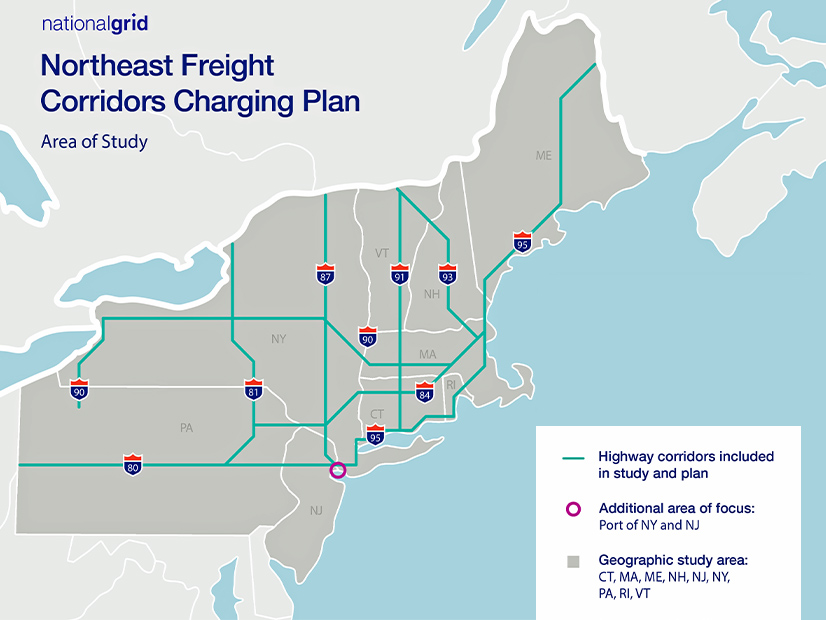
A consortium has begun working to anticipate the charging infrastructure needed in the next 20 years for heavy-duty electric trucks across nine Northeast states.
A consortium has begun working to anticipate the charging infrastructure needed in the next 20 years for heavy-duty electric trucks across nine Northeast states.
National Grid is leading the effort, which benefits from a $1.2 million grant from the Department of Energy. It will result in a road map predicting the supporting infrastructure needed for electrified transport of goods in one of the nation’s busiest areas.
Nearly 3,000 miles of interstate highway corridors in New York, New Jersey, Pennsylvania and New England will be examined, with major commercial zones such as the Port of New York and New Jersey folded in because of their traffic density.
National Grid will coordinate its efforts with CALSTART, which received a similar DOE grant to map out truck-charging needs across a smaller area running south to Georgia.
Combined, the two analyses will span 3,700 miles across 15 states and movement of more than 300 million tons of freight through East Coast ports.
Brian Wilkie, National Grid’s director of transportation electrification in New York, said 100 charging sites will be analyzed initially but their ranks will be winnowed down to about 30 as the “Northeast Freight Corridors Charging Plan” takes shape.
The final product will be offered as a starting point for decisions on how to prepare for electrification of heavy trucks, as is mandated in some states. Given the rapid technological evolution of vehicles, storage and charging, Wilkie said, the report will not be a final action plan but a road map for drawing up action plans.
The speed of transportation electrification is almost certain to exceed the speed of transmission development, he said, so it’s imperative to build infrastructure before the need arises — a concept traditionally anathema to transmission planners because of risk of overbuilt or stranded assets.
“Our infrastructure won’t be able to keep pace if we don’t start building ahead of the need,” Wilkie told NetZero Insider on Tuesday. “Given what we see in the [building] heating electrification space and the transportation electrification space, we’re not going to have much in the way of stranded assets.”
CALSTART President John Boesel pointed out the policy benefits of the study, as well. He said in a news release: “The I-95 Corridor project, once completed, will put into practice the integration of zero-emission vehicles, infrastructure and addressing climate-change issues that has been carried out in other areas of the country. The successful implementation of this project will put to rest the unfounded concerns of zero-emission opponents by demonstrating that this technology is both economically feasible and a benefit to all.”
There is no estimate at this point how many plugs and gigawatts would be needed for a Northeast truck charging network.
But in 2022, the first-in the nation “Electric Highways Study,” also led by National Grid, concluded a network of about six dozen fast-charging plazas would be needed for light- and heavy-duty vehicles just in New York and Massachusetts, each able to meet 2045 peak demand of 15 to 40 MW, perhaps even more.
That is like adding a mix of 72 athletic stadiums, small towns and large factories to the grid. With the associated upgrades in generation and transmission, it’s a major undertaking.
Add seven more states and include heavy-duty fast chargers drawing up to 1 MW each and the challenge of electrifying trucking becomes clearer, even if it cannot be quantified yet.
The new study builds on its predecessor but will take a broader perspective.
National Grid is joined in the effort by Clean Communities of Central New York, the National Renewable Energy Laboratory, the Northeast States for Coordinated Air Use Management and RMI.
The effort is technology-neutral, and it must be, given that emissions-free transportation will evolve to a significant degree but in unknown directions over the next 20 years. The assumption is that hydrogen will account for only a small fraction of the heavy-duty fleet and that new wireless charging concepts will not be part of the mix.
Generation and transmission capacity are not part of the study because they are the purview of the RTOs in the nine-state region, but the RTOs’ input will be sought.
The study is focused instead on point of delivery. National Grid is working with industry and other utilities to better estimate the need for chargers and the need for local infrastructure to support them, such as substations.
“One of the things that makes this transformational, one we’re very proud of, is traditionally, transportation planning has happened in one silo and utility planning has happened in another, and they’ve never really spoken to each another,” Wilkie said.
But now they are working together on an integrated structure, and this will be central to the success of the effort.
“It hasn’t been easy. We speak different languages, but here we’re trying to get all the right stakeholders in the room to have that conversation,” he said.
When the study wraps up, the report goes to DOE for consideration.
“We’re trying to make this plan as actionable as possible,” Wilkie said. “So, not just identifying the power needs but the utilities that we partner with will all be looking at, ‘How would you serve a load like that in that particular place in our territory?’”
That’s the underlying question the study seeks to address, if not completely answer.
“There’s a lot of unknowns about where all this charging will take place and what the power needs are,” he said. “We don’t know the exact number, but we know the numbers are pretty big.”


